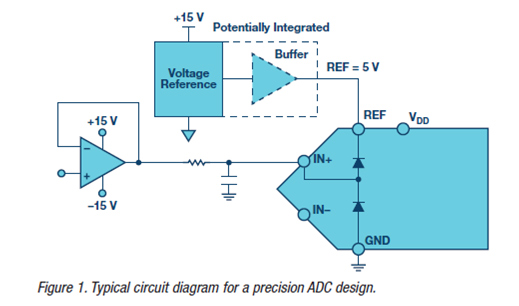A common issue that arises when designing an ADC circuit is how to protect the ADC inputs from overvoltage. The protection of ADC inputs has many scenarios and potential solutions. ADCs from all vendors have similar needs in this respect. This article gives insight into what issues can arise in the case of overvoltage, how it occurs, and potential remedies.
Overdrive of ADC inputs generally occurs when the rails of the driving amplifier are significantly greater than the max input range of the ADC— for example, if the amplifier runs from ±15 V and the ADC input is 0 V to 5 V. This is particularly common in industrial designs where high voltage rails are used to accept ±10 V inputs and also power signal conditioning/ driver stages prior to the ADC, such as PLC modules. If a fault condition occurs such that the driving amplifier rails, it can cause damage to the ADC by exceeding its max rating or disturb simultaneous/subsequent conversions in a multiADC system. This article will focus on how to protect a precision SAR ADC like the AD798x family, but it can also be applied to other ADC types.
Let’s consider the scenario in Figure 1.
 This circuit is representative of what we see in the AD798x (for example, the AD7980) family of PulSAR® ADCs. There are protection diodes between the input, the reference, and the ground. These diodes are capable of handling high currents of up to 130 mA, but only for a few milliseconds— not for longer periods or repeated overvoltage. On some products, like the AD768x/AD769x (for example, the AD7685, AD7691) family of parts, the protection diodes are to the VDD lead instead of the REF. On these parts, the VDD voltage is always greater than or equal to REF. Generally this works better as VDD is a stiffer rail for clamping and is not as sensitive to disturbance.
This circuit is representative of what we see in the AD798x (for example, the AD7980) family of PulSAR® ADCs. There are protection diodes between the input, the reference, and the ground. These diodes are capable of handling high currents of up to 130 mA, but only for a few milliseconds— not for longer periods or repeated overvoltage. On some products, like the AD768x/AD769x (for example, the AD7685, AD7691) family of parts, the protection diodes are to the VDD lead instead of the REF. On these parts, the VDD voltage is always greater than or equal to REF. Generally this works better as VDD is a stiffer rail for clamping and is not as sensitive to disturbance.
In Figure 1, if the amplifier was to rail toward the +15 V rail, the protection diode to REF will turn on and the amplifier will try to drag the REF node up. If the REF node is not driven by a strong driver circuit, then the voltage at the REF node (and input) will rise above the absolute maximum rated voltage and the ADC may be damaged if the voltage exceeds the breakdown voltage of devices on that process. See Figure 3 for an example of the ADC driver railing toward 8 V and overdriving the reference voltage (5 V). Many precision references have no sink current capability, which is a problem in this scenario. Alternatively, the reference drive circuit may be strong enough to hold the reference close to its nominal value, but will still be disturbed from its precise value.
In a simultaneous sampling multi-ADC system sharing the one reference, the conversions on the other ADCs will be inaccurate, as the system depends on a highly accurate reference voltage. Subsequent conversions may also be inaccurate if the recovery time from the fault condition is long.
There are a few different approaches used to mitigate this issue. The most common is to use Schottky diodes (BAT54 series) to clamp the output of the amplifier to the range of the ADC. See Figure 2 and Figure 3 for an illustration. It may also be possible to use diodes to clamp the input to the amplifier if it suits the application needs.
 In this case, the Schottky diodes are chosen for their low forward voltage drop, such that they turn on before the internal protection diodes in the ADC. The series resistor after the Schottky diodes also helps limit the current into the ADC if the internal diodes turn on slightly. For extra protection, if the reference has little to no sink current capability, a Zener diode or clamp circuit could be used on the reference node to guarantee the reference voltage cannot be pulled too high. In Figure 2, a 5.6 V Zener diode is used for a 5 V reference.
In this case, the Schottky diodes are chosen for their low forward voltage drop, such that they turn on before the internal protection diodes in the ADC. The series resistor after the Schottky diodes also helps limit the current into the ADC if the internal diodes turn on slightly. For extra protection, if the reference has little to no sink current capability, a Zener diode or clamp circuit could be used on the reference node to guarantee the reference voltage cannot be pulled too high. In Figure 2, a 5.6 V Zener diode is used for a 5 V reference.

 An example is shown in Figure 4 of the effect on the reference input (5 V) of adding Schottky diodes to the ADC input when overdriving the ADC input with a sine wave. The Schottky diodes are connected to the ground and a 5 V system rail capable of sinking current. Without the Schottky diodes, there is a reference disturbance when the input exceeds the reference and ground by a diode drop. As can be seen, the reference disturbance is completely removed with the Schottky diodes.
An example is shown in Figure 4 of the effect on the reference input (5 V) of adding Schottky diodes to the ADC input when overdriving the ADC input with a sine wave. The Schottky diodes are connected to the ground and a 5 V system rail capable of sinking current. Without the Schottky diodes, there is a reference disturbance when the input exceeds the reference and ground by a diode drop. As can be seen, the reference disturbance is completely removed with the Schottky diodes.
Attention needs to be paid to the reverse leakage current of the Schottky diodes, as this may introduce distortion and nonlinearity during normal operation. This reverse leakage is very temperature dependent and is generally specified in the diode data sheet. A good option is the BAT54 series of Schottky diodes (2 μA max at 25°C, ~100 μA at 125°C).
A way of eliminating overvoltage issues completely is to use a single-supply rail for the amplifier. This means the driving amplifier can never swing below ground or above the max input voltage if the same supply level is used as for the reference voltage (max input voltage), which is 5 V in this example. It may be possible to use the reference circuit to supply the amplifier directly if it has sufficient output current and drive strength. Another possibility, as shown in Figure 5, is to use a slightly lower reference value (for example, 4.096 V when using a 5 V rail), resulting in significantly reduced voltage overdrive capability.
These approaches solve any issue with overdriving the input, but the trade-off will be limited input swing and range to the ADC because of the amplifier’s headroom and footroom requirements. Typically, a rail-to-rail output amplifier can get within 10s of mVs of the rail, but it is also important to consider input headroom requirements, which can be 1 V or more, as this will limit the swing further in a buffer and unity-gain configuration. This approach offers the simplest solution in terms of no additional protection components needed but depends on having the correct supply voltage and possibly a rail-to-rail input/output (RRIO) amplifier.
 The series R in the RC filter between the amplifier and the ADC input can also be used to limit the current seen at the ADC input during an overvoltage condition. However, this will be a trade-off between current limiting and ADC performance. Larger series R will give better input protection but result in greater distortion in the ADC performance. This may be an acceptable trade-off, especially if the input signal bandwidth is low or the ADC is not being run at the full throughput rate, as more series R can be tolerated in this case. The size of R acceptable for the application can be determined experimentally.
The series R in the RC filter between the amplifier and the ADC input can also be used to limit the current seen at the ADC input during an overvoltage condition. However, this will be a trade-off between current limiting and ADC performance. Larger series R will give better input protection but result in greater distortion in the ADC performance. This may be an acceptable trade-off, especially if the input signal bandwidth is low or the ADC is not being run at the full throughput rate, as more series R can be tolerated in this case. The size of R acceptable for the application can be determined experimentally.
As discussed earlier in the article, when protecting the ADC input there is no silver bullet solution, but depending on the application requirements, different individual or combined approaches may be taken to give the desired level of protection with corresponding performance trade-offs.

About Author
Alan Walsh [alan.walsh@analog.com] is an applications engineer at Analog Devices. He joined ADI in 1999 and works in the Precision Converters Applications Group in Wilmington, Massachusetts. He graduated with a BEng in electronic engineering from University College Dublin.








